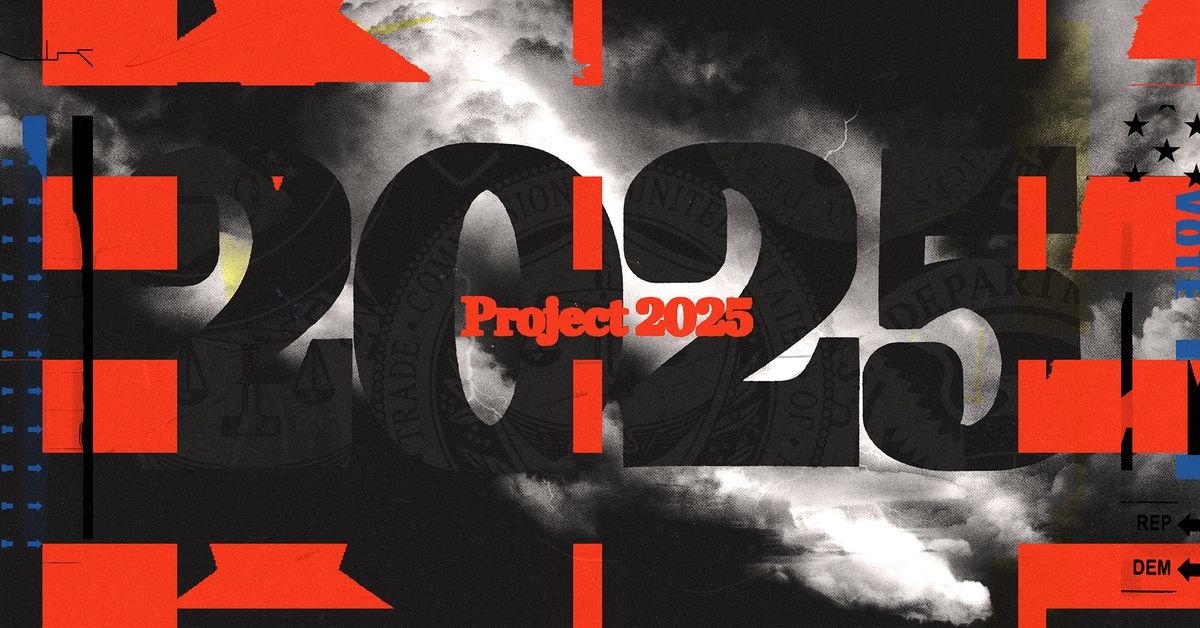For the better part of this year, Project 2025 has been a catchall among Democrats for the threat former President Donald Trump poses to American society. The more than 900-page Mandate for Leadership, crafted by conservative think tank the Heritage Foundation, is a sprawling and often contradictory mix of ideas from more than 100 organizations. It’s tied together not by unified policy predictions but by a series of preoccupations: China; “wokeness”; climate denialism; and a commitment to gutting or abolishing federal agencies. It includes plans that would remake America’s approach to technology, but like many things in the document, its authors can’t exactly agree on how.
Technology
Google Photos to soon reveal whether AI was used to edit photographs- The Week

As part of its initiative to improve transparency in using Artificial Intelligence tools, Google Photos will soon highlight whether its AI tools were used while editing an image. According to Google, the new feature will be rolled out in the Photos app from next week.
In a recent blog, Google said with the increasing use of AI for photo editing, especially with the use of its editing tools like magic editor and magic eraser in the Photos app, it will highlight the use of AI tools as part of its steps to improve transparency. If AI tools have been used to edit an image, it will be shown along with the file name, the tech giant said.

“As we bring these tools (Magic editor and magic eraser) to more people, we recognize the importance of doing so responsibly with our AI Principles as guidance. To further improve transparency, we’re making it easier to see when AI edits have been used in Google Photos. Starting next week, Google Photos will note when a photo has been edited with Google AI right in the Photos app,” John Fisher, the engineering director of Google Photos said in a blog.
Google noted that already photos edited with its tools like magic editor, magic eraser and zoom enhance include metadata based on technical standards from The International Press Telecommunications Council (IPTC) to indicate that they’ve been edited using generative AI. “Now we’re taking it a step further, making this information visible alongside information like the file name, location and backup status in the Photos app,” he said.
Technology
The grievance-driven blueprint for the next Trump administration

Trump has attempted to distance himself from the policy plan, but it’s tied to him by numerous threads. His running mate, JD Vance, is friends with Kevin Roberts, the president of the Heritage Foundation, and Vance even wrote the introduction to Roberts’ forthcoming book, Dawn’s Early Light. (The book’s publication, initially slated for September, was postponed until after the election.) And some of Project 2025’s chapters were written by Trump’s own former administration officials, including FCC commissioner Brendan Carr and Department of Homeland Security official Ken Cuccinelli.
If Trump is elected, it’s highly likely that some of Project 2025’s ideas would be implemented — we just don’t know which ones. The most provocative proposals, like banning pornography, are prominently highlighted but never explained. Authors, in turn, recommend fighting and embracing tech companies. “I don’t think I’ve encountered a single person in America who agrees with 100 percent,” Roberts said at the Reboot Conference in San Francisco in September. “It’s like the menu at the Cheesecake Factory.”
Much of what’s on the menu is notably less delicious. We’re not going to break down every piece of Project 2025 here — you can find more general guides at CBS News, which showed how many of Project 2025’s policy recommendations match Trump’s own; ProPublica, which obtained secret training videos created for Project 2025’s Presidential Administration Academy; and The New York Times, which interviewed several former Trump officials involved in the creation of Project 2025. Instead, we’re taking a look at how its recommendations would affect tech at every level, from how companies can hire foreign workers to the social media platforms we use every day.
Though there are some contradictions between and within chapters — signs of fissures or points of contention among the dozens of participating organizations — Project 2025 does, in the end, amount to a coherent vision. The document calls for a radical expansion of government power to punish conservatives’ enemies in tech, oust potential dissenters within the federal bureaucracy, and enforce right-wing wish list items like mass deportations and a national abortion ban. All of this would be combined with mass deregulation and the defunding of social services and federal agencies that contribute to the public welfare. Project 2025’s authors want small government for social goods — but big government for retribution.
Federal Trade Commission
Authored by: Adam Candeub, a professor of law at Michigan State University. Candeub served as the acting assistant secretary of commerce for telecommunications and information under Trump. From 2020 to 2021, he was the deputy associate attorney general in Trump’s Department of Justice.
Project 2025’s FTC guidelines are perhaps the clearest example of conservative ambivalence toward tech. The section doesn’t actually offer a set of policy proposals. Instead, it outlines two diametrically opposed approaches: one where the Trump administration fiercely enforces antitrust law to break up monopolies; and another where it does barely anything at all.
In the enforcement route, Project 2025 suggests using the FTC to rein in major corporations, especially big tech companies. It puts forward the European Union’s “less friendly regulatory environment” as a good model, possibly referring to EU laws like the Digital Markets Act, which have forced tech companies to make major hardware and software changes to their products. It encourages the FTC to partner with state attorneys general to scrutinize or block hospital, supermarket, and big tech mergers. And it recommends that the FTC look into whether social media platforms’ advertising to and contract-making with children constitute unfair trade practices.
While there’s overlap with Democratic antitrust priorities here, there’s also a focus on clearly partisan concerns. The chapter suggests investigating whether social media platforms censored political speech in collusion with the government, following up on probes by the Republican-led House of Representatives and Republican state attorneys general. (Hunter Biden’s laptop, unsurprisingly, gets a mention.) You’ll also see references to issues like the “de-banking” of controversial figures, which the Trump family has cited as an inspiration for its mysterious crypto platform. “We are witnessing in today’s markets the use of economic power — often market and perhaps even monopoly power — to undermine democratic institutions and civil society,” the chapter claims.
Each of these points is contradicted by a long-standing conservative counterpoint: the government should let the market regulate itself. If the FTC regulates how children use internet platforms, for example, it could undermine conservatives’ calls for “parental empowerment on education or vaccines.” Expanding cooperation between the FTC and state attorneys general could “tie middle America to big progressive government.”
Ultimately, though, the chapter seems to favor intervention. Conservatives “cannot unilaterally disarm and fail to use the power of government to further a conservative agenda,” it warns, even if their goal is to do away with the regulatory state.
Federal Communications Commission
Authored by: Brendan Carr, a member of the Federal Communications Commission who was appointed by Trump in 2017.
Much of this chapter focuses on “reining in” major tech companies. Carr proposes a host of policies, including eliminating certain immunities under Section 230 of the Communications Decency Act and “clarifying” that Section 230’s key 26 words should only be used in cases about platforms failing to remove illegal material posted by users, not as a broader shield for moderation decisions.
Carr’s real concern is with social media platforms’ alleged suppression of conservative speech. The chapter suggests requiring “Big Tech” to follow net neutrality-like rules similar to those for broadband providers, like disclosure on practices such as blocking and prioritizing content. Platforms should also be required to “offer a transparent appeals process” when user content is taken down.
The chapter also suggests that the FCC regulatory power should be expanded with “fundamental Section 230 reforms” that let it regulate how online platforms moderate content — or, in Carr’s words, “no longer have carte blanche to censor protected speech.” Carr describes Texas’ HB 20 — the law that forbids platforms from removing, demonetizing, or downlinking posts based on “viewpoint,” which set the stage for NetChoice v. Paxton — as a possible model for federal legislation.
As companies must stop “censoring” conservative speech, they’re supposed to restrict children from accessing certain social media platforms. Carr quickly notes that these views “are not shared uniformly by all conservatives,” but as is the case in other chapters, the notion of expanding government powers to punish right-wing opponents ends up winning out over a more laissez-faire approach.
Congress should also require big tech to pay into the FCC’s Universal Service Fund, which helps fund broadband access in rural communities and is currently funded by broadband providers. It’s another example of Project 2025’s movement away from Reagan-era “small government” conservatives in favor of punishing disfavored targets with more regulation.
The chapter also recommends that the FCC and White House work together to free additional airwaves for commercial wireless services and generally do more to “move spectrum into the commercial marketplace.” Carr also recommends that the government build out internet infrastructure on federally owned land. The latter, however, can’t be accomplished by the FCC alone, and Carr notes that it would require working with the Bureau of Land Management and the Forest Service, among other agencies. The chapter also recommends that the FCC more quickly review and approve applications to launch new satellites, specifically for the purposes of supporting StarLink, Kuiper, and similar efforts.
And then there’s China. One of the primary recommendations is that the FCC “address TikTok’s threat to national security.” (Congress has, since the time the Mandate for Leadership was published, done just that by attempting to ban the app unless it divests from its parent company, ByteDance; whether the courts will let that happen remains to be seen.) Others include creating a more regular process to review entities “with ties to the CCP’s surveillance state” and stopping US entities “from indirectly contributing to China’s AI goals.”
Financial regulatory agencies
Authored by: David R. Burton, a senior research fellow in economic policy at the Heritage Foundation; and Robert Bowes, a senior adviser to the assistant secretary of the Department of Housing and Urban Development under Trump and former adviser to Trump aide Stephen Miller.
While other sections are often ambivalent about government regulation, this chapter straightforwardly suggests giving major concessions to cryptocurrency and loosening restrictions on who can invest in private companies.
Anyone who’s been following Trump’s attempts to court the crypto community should know what’s coming here. There are a host of recommendations for the Securities and Exchange Commission, which the authors say has “chosen regulation by enforcement” for cryptocurrency. The biggest change would be redefining digital assets as commodities, instead of securities, so they’re no longer regulated by the SEC.
The chapter also recommends making private capital raising less restrictive by changing a rule known as Regulation D. Under Regulation D, companies can raise unlimited funds for securities from an unlimited number of “accredited investors,” with no disclosure needed to the SEC. “Accredited investors” must currently have a salary of $200,000 (or $300,000 combined with their spouse) or a net worth of at least $1 million, excluding their primary residence. As of 2022, more than 24 million American households met these requirements. Project 2025 recommends broadening these qualifications or eliminating them altogether.
In practice, this would let anyone invest in any private company, not just — as the rule stands today — companies on the public market. To go public, companies have to meet certain requirements and file a registration statement with the SEC, where they’re subject to reporting requirements. In exchange, they currently get access to a much broader pool of potential investors. Eliminating the accredited investor requirement would effectively allow companies to skirt the requirements of going public — and the oversight they’re subject to afterward.
Department of Commerce
Authored by: Thomas F. Gilman, the director of ACLJ Action, a conservative organization affiliated with the American Center for Law and Justice. Gilman was the chief financial officer and assistant secretary for administration of the US Department of Commerce under Trump.
This sprawling chapter touches on nearly every major Project 2025 theme, from fears of China to the “alarm industry” of federal climate monitoring. Like practically every other section, it recommends expanding the federal government’s reach if it will advance conservative interests and doing away with any agencies that don’t.
In keeping with the goal of dismantling federal bureaucracies, this chapter suggests doing away with the National Oceanic and Atmospheric Administration (NOAA), which it says should be privatized or placed under the control of states and territories. Other agencies, like the National Weather Service (NWS) and Office of Oceanic and Atmospheric Research, would be severely downsized. (In a statement provided to the Los Angeles Times, Steven R. Smith, the CEO of AccuWeather — which Project 2025 suggested could replace the NWS — said AccuWeather’s forecast engine partly relies on NOAA data.) These agencies provide the data used in weather forecasts accessed by millions of Americans each day and also give the public crucial information about impending hurricanes, heatwaves, and other natural disasters and extreme weather events.
The Republican libertarian wing may get its goal of privatizing federal agencies, but most of this chapter argues for more — not less — government interference in the market. Noting that China has made significant advances in semiconductor design, aerospace technologies, and other crucial industries, it recommends new rules to prevent tech transfer to foreign adversaries. It also suggests an executive order expanding the Export Control Reform Act of 2018 to restrict exports of Americans’ data. And it opposes intellectual property waivers for “cutting-edge technologies” like covid-19 vaccines — which an earlier chapter says the Centers for Disease Control and Prevention shouldn’t encourage people to get — through international agreements. These waivers, which were hotly debated for years following the onset of the pandemic, give low- and middle-income countries access to life-saving immunizations, though advocates say more needs to be done to achieve global vaccine equity.
The chapter also suggests adding certain app providers — including WeChat, TikTok, and TikTok’s parent company, ByteDance — to the entity list, which would prevent the apps from issuing program updates in the US, effectively making them nonoperational. The Heritage Foundation apparently didn’t get the memo that Trump loves TikTok now.
Department of Transportation
Authored by: Diana Furchtgott-Roth, director of the Heritage Foundation’s Center for Energy, Climate, and Environment.
Unlike other chapters that are openly antagonistic toward tech companies, this chapter suggests partnering with the private sector to “revolutionize travel.” There’s an emphasis on private transportation over public transportation — not just in terms of opposing government funding for mass transit but also supporting ridehailing apps, self-driving vehicles, and micromobility, which only gets a passing mention in the chapter but likely refers to e-bikes and electric scooters.
Current policies, the document says, “strangle the development of new technologies” like drones. Instead, the DOT should encourage the use of small aircraft for air taxis or for quiet vertical flights. It should also push for a shift to digital or remote control towers for planes, letting flights be managed “anywhere from anywhere.”
Department of the Treasury
Authored by: William L. Walton, a trustee of the Heritage Foundation and the founder and chair of the private equity firm Rappahannock Ventures LLC; Stephen Moore, a visiting fellow in economics at the Heritage Foundation; and David R. Burton, a senior research fellow in economic policy at the Heritage Foundation.
Under Project 2025, the US would effectively abandon its commitment to stopping climate change. The chapter suggests getting rid of the department’s Climate Hub office and withdrawing from international climate change agreements, including the Paris agreement and the United Nations Framework Convention on Climate Change. Instead of focusing on clean energy or climate change-resilient infrastructure, the chapter suggests that the government should invest in domestic energy, especially oil and gas.
Like several other sections, this chapter takes aim at “wokeness” and diversity, equity, and inclusion (DEI) programs. As part of Project 2025’s plan to gut the federal workforce, it suggests identifying all Treasury officials who have participated in DEI initiatives, publishing their communications about DEI, and firing anyone who participated in DEI initiatives “without objecting on constitutional or moral grounds.”
Department of Health and Human Services
Authored by: Roger Severino, a vice president at the Heritage Foundation and former director of its DeVos Center for Religion and Civil Society, who served as the director of the HHS’s Office of Civil Rights under Trump.
The bottom line: Project 2025 would limit the government’s ability to do basic health governance while setting up a surveillance state for pet conservative issues like abortion and gender-affirming care for trans people.
Much of the HHS chapter focuses on the Centers for Disease Control and Prevention’s response to covid-19, which the author characterizes as near totalitarian. The chapter recommends barring the CDC from saying that children should be masked or vaccinated against any illness and says that the CDC should be investigated for “colluding with Big Tech to censor dissenting opinions during Covid.” The author also suggests moving several CDC programs — including the Clinical Immunization Safety Assessment project, which researches vaccine safety — to the Food and Drug Administration.
Unsurprisingly, abortion would be severely restricted. Under Project 2025, the FDA would reverse the approval of pills that facilitate medication abortions, which the document calls the “single greatest threat to unborn children.” The FDA would also eliminate policies allowing people to order abortion pills by mail or online. As the CDC would stop encouraging vaccinations — which some conservatives believe infringe on bodily autonomy — the agency would increase its surveillance and recordkeeping of abortions and maternal mortality. This includes a recommendation that the HHS “use every available tool, including the cutting of funds” to force states to report “exactly how many abortions take place within its borders.”
A separate study, through the National Institutes of Health, is recommended to investigate the “short-term and long-term negative effects of cross-sex interventions,” i.e., gender-affirming care. The report also recommends using AI to detect Medicaid fraud, which costs the US an estimated $100 billion a year and is typically perpetrated by healthcare providers, not individual beneficiaries of public healthcare.
Department of Homeland Security
Authored by: Ken Cuccinelli, who served in various capacities under Trump, including as the director of US Citizenship and Immigration Services and, later, the “senior official performing the duties of the Deputy Secretary of Homeland Security.”
Perhaps counterintuitively given Republicans’ laser focus on the US border, Project 2025 recommends abolishing the Department of Homeland Security. The goal, though, is to replace it with the Border Security and Immigration Agency, a new, more draconian, and less accountable immigration enforcement apparatus.
The Transportation Security Administration (TSA) would be privatized, and the Coast Guard would be moved to either the Department of Defense or the Department of Justice. Dismantling the DHS almost certainly won’t happen — it would require an act of Congress, and lawmakers haven’t passed an immigration bill in decades.
Project 2025 doesn’t just recommend more stringent restrictions on unauthorized immigration; it also lays out a vision of severely restricted legal immigration. It recommends scrapping the family-based immigration system that has been in place since 1965 and replacing it with a “merit-based system that rewards high-skilled aliens.” Other suggestions include eliminating the diversity visa lottery and altering the work visa system. This, too, would largely require congressional action.
As it prioritizes “merit-based” immigration to the US, the chapter proposes limiting foreign students’ ability to study here. In a move that (unlike much of this chapter) could be accomplished through executive action, it proposes ending what it calls Immigration and Customs Enforcement’s (ICE) “cozy deference to educational institutions,” i.e., the issuing of student visas to most foreign students admitted to US universities. It also calls to “eliminate or significantly reduce the number of visas issued to foreign students from enemy nations” — implicitly, China.
Intelligence community
Authored by: Dustin J. Carmack, Meta’s director of public policy for the Southern and Southeastern US. Carmack, a former research fellow at the Heritage Foundation, was the chief of staff for the Office of the Director of National Intelligence under Trump from 2020 to 2021.
Concerns about China are far more explicit in this chapter, which looks at the “vast, intricate bureaucracy of intelligence agencies within the federal government.” The chapter raises the threat of Chinese (and to a lesser extent, Russian) espionage, online influence campaigns, and “legitimate businesses serving as collection platforms,” a possible allusion to TikTok. The Mandate for Leadership recommends amending Executive Order 12333 — which was signed by President Ronald Reagan in 1981 and, among other things, authorizes mass data collection for intelligence purposes to address the threats the US and its allies face “in cyberspace.”
But the chapter also claims intelligence agencies have dedicated far too much time to surveilling the former president, which allegedly proves a “shocking extent of politicization” among the agencies and the officials who lead them. (Its evidence includes the letter signed by 51 former intelligence officials ahead of the 2020 US presidential election claiming that the story about Hunter Biden’s laptop was likely a Russian information operation.) The author calls for an investigation into “past politicization and abuses of intelligence information.”
The chapter also recommends that Section 702 of the Foreign Intelligence Surveillance Act (FISA) — the controversial law allowing warrantless wiretapping that was reauthorized earlier this year — be reformed with “strong provisions to protect against partisanship,” pointing to the use of FISA to surveil former Trump campaign associate Carter Page as part of the FBI’s investigation into Trump’s ties to Russia. There is little mention of how these vast surveillance powers affect regular people. In fact, the chapter notes that an independent review found that Section 702 surveillance powers were “not abused,” though it does recommend that Congress review further reports to determine whether any FISA reforms are needed.
Buried amid all these claims, it also recommends the Department of Defense examine the possibility of joint satellite and space programs with “potential allied nations” to counter the threat posed by Russia and China. Additionally, it suggests agencies spy on the space programs of foreign adversaries and collect more data on adversaries’ potential threats to US space programs.
Media agencies
Authored by: Mora Namdar, a former State Department official who worked as a senior policy adviser and acting assistant secretary of state in consular affairs under Trump; and Mike Gonzalez, a former journalist and current senior fellow at the Heritage Foundation.
These agencies aren’t as consequential as juggernauts like the FTC, but the usual slash-and-burn recommendations apply. Project 2025 encourages undercutting the Open Technology Fund, a subagency within the US Agency for Global Media dedicated to protecting free speech around the world that has funded open-source projects like Signal. It calls the OTF a “wasteful and redundant boondoggle” that makes “small, insubstantial donations to much larger messaging applications and technology to bolster its unsubstantiated claims” and — contra its name and stated mission — suggests it fund closed-source technology instead.
The chapter also notes that there is “vast concern” about the vulnerability of undersea cable trunks that power the internet and says that major global conflict could cause widespread damage to these cables, potentially leading to long-lasting power outages. There is no mention of what can be done to prevent this, though the chapter does say that the US Agency for Global Media’s shortwave radio capabilities could help carry broadcasts and maintain communication in areas where online traffic is limited or restricted.
Technology
Apple is testing a new blood-sugar product, but it’s not the Apple Watch update we’ve been waiting for

A new report claims that Apple has secretly tested an app that could help customers with prediabetes manage their food, and make lifestyle changes that could one day help shape the company’s health software.
We’ve been hearing reports for years that Apple has been trying to crack blood glucose monitoring on its best Apple Watch models, to no avail up until now.
The latest reports indicate that Apple’s non-invasive blood glucose tech (rather than “invasive” technology like continuous glucose monitors, so called because they use needles to pierce the skin) might still be years away. However, in the meantime, Apple appears to be testing an app that could help in the fight against diabetes.
Writing in his weekly Power On Newsletter, Bloomberg’s Mark Gurman reports that Apple this year tested an app “to help people with prediabetes manage their food intake and make lifestyle changes.”
According to the report, Apple doesn’t currently have plans to release the app, but may integrate the technology into its future health products, “including a noninvasive glucose tracker that it’s been developing for more than a decade.”
Apple’s secret diabetes app

The app could reportedly show consumers how certain foods impact their blood sugar levels, based on measurements taken by existing blood sugar monitoring devices.
Gurman says the study was aimed at exploring uses for blood sugar data and what tools Apple could create for consumers as a result. Latterly, he reports testing on the app has been paused, but says the tests could pave the way for better food tracking on Apple’s own health software or better third-party glucose tracking integration.
In the meantime, the report states that Apple’s non-invasive blood glucose tech is “still years away”. Its current prototype is an “iPhone-sized” device, but even at that scale, Apple is battling overheating and miniaturization challenges. Apple’s system features lasers that shoot light into the skin with a view to providing specific blood sugar readings, even if early iterations may only be able to tell people if they’re prediabetic.
While some knock-off smartwatches claim to include glucose monitoring, none of the best smartwatches out there actually offer the feature because of the aforementioned technical challenges. The FDA went so far as to warn against using smartwatches or even smart rings to measure blood glucose earlier this year.
You may also like
Technology
Strategies for effective messaging- The Week

The best graduation speeches dispense wisdom you find yourself returning to long after the graduation tassels are turned. Take the feel-good life advice in Baz Luhrmann’s song to a class that graduated 25 years ago. Only on a recent relisten did I realize it also captures one of the research-based strategies I teach for avoiding communication that backfires.
The tip is hiding in plain sight in the song’s title, Everybody’s Free (to Wear Sunscreen). Communication aimed at promoting a certain behavior can have the opposite effect when the message is perceived as a threat to individual autonomy.
Health campaigns frequently use strongly worded messages that end up backfiring. For example, strongly worded messages promoting dental flossing made people angry and more likely to resist flossing their teeth. Coercive alcohol prevention messages, with language like any reasonable person must acknowledge these conclusions, instead increased alcohol consumption. In contrast, the wording of the title Everybody’s Free (to Wear Sunscreen) is less likely to backfire by emphasizing liberty of choice.
Research reveals lots of reasons why well-meaning attempts to inform, persuade or correct misinformation go awry. Despite the ubiquity of backfires, formal instruction about why they happen and how to avoid them is rare. The omission inspired my new book, Beyond the Sage on the Stage: Communicating Science and Contemporary Issues Effectively, which translates scholarship from across disciplines into practical strategies that anyone can use to improve communication.
When new info challenges your identity
Backfires are often a response to communication of unwelcome information.
In addition to threats to autonomy, information can be unwelcome because it appears to conflict with how you think about yourself. Consider a study that asked people to read a message about genetically modified foods. Participants for whom purity, health and conscientiousness of their diet was an important part of how they defined themselves had more negative attitudes after reading a message intended to refute their views about GM food. Those who did not have a strong dietary self-concept did not react negatively to the message.
The same resistance can rise up when you’re confronted with something counter to the beliefs of a group you feel a strong affiliation with. Emotional and identity attachment to a group such as a political party can cause people to subjugate their own values to align with the group, a phenomenon called cultural cognition. Reactions to messages about climate change often exemplify this phenomenon.
Against the backdrop of protests and an impending election, communication breakdowns are increasingly blamed on political polarization, with more than a hint of fatalism. But the current heavy focus on ideological differences serves only to fuel a vicious cycle that amplifies them. To halt the cycle, the focus needs to shift away from the differences. Divides are not always what they seem, and even when they are, there are often ways to bridge them.
Every person contains multitudes
Encouragingly, a study recently published by the Pew Research Center found that just 11% of Americans consider it very or extremely important that they get their news from journalists who share their political views. Less than 40% of Americans said that it was even somewhat important. The study is a reminder that we are all complex mixes of identities, and those distinct identities can offer fruitful starting points for a conversation.
As the various identities within people interact, the context can bring a particular identity to the fore. For example, a study that examined the importance of voters’ identity as parents revealed that when thinking about their children, people were more willing to oppose the policies of their own political party. Animal lover is another example of an identity that researchers have time and again seen relegate party identity to the background.
Therefore, appealing to a shared identity is a strategy for bridging the divide.
Another strategy is to make it safe to go against the group without damaging an individual’s connection to it. For example, people may act anonymously, which is what happened during the pandemic when some people reportedly chose to wear disguises when getting their COVID-19 vaccine.
Accidentally conveying what you don’t mean
As in the case of threats to autonomy, the language you choose can minimize backfires caused by threats to group affiliations. People may agree that a proposed action is sound and consistent with their party’s beliefs but still reject it if it contains even small polarizing cues. Triggers, such as words associated with the opposing party such as tax for a conservative or deregulation for a liberal, lead people to judge that their party would reject a policy. The fix is to remove both real and perceived threats to group identity by using party-neutral language.
Surprisingly, communication need not be threatening or unwelcome to backfire. It can happen when communication contains hidden unintended messages or when it inadvertently makes an undesired behavior seem normal. For example, messages from a utility about reducing energy use caused low-energy users to consume more energy when their consumption was compared with others, and anti-littering posters emphasizing the extent of the problem increased littering.
Another intuitive communication strategy that backfires is presenting information in a myth-versus-fact format. You’ve probably seen this format used in communications aimed at debunking myths about health, science, technology, culture and more. Yet, research demonstrates that the state-and-negate format makes it more likely people will remember myths as facts. A facts-only approach improves retention of the correct information.
Research finds where instincts lead you astray
Everybody’s Free (to Wear Sunscreen), originally penned as a newspaper column by journalist Mary Schmich, doesn’t tell graduates to trust their instincts, but that is commonly dispensed commencement advice.
The research demonstrates that when it comes to effective communication strategies, trusting your instincts can lead you astray. The same research provides insight into why you may instinctively react in certain ways to some messages.
So, if I were to offer this year’s graduates just one tip for the future, I would encourage them to check their communication instincts against evidence-based recommendations. I would call my speech Everybody’s Free (to Beat Backfire).
(The Conversation: By Sherry Seethaler, University of California, San Diego)
Technology
Stop! And watch these 3 great movies leaving Netflix by November 1

Unfortunately, the end of the month on Netflix means several movies will be exiting the service. Several movies with Chucky the killer doll — including Bride of Chucky, Child’s Play 2, and Child’s Play 3 — are leaving right after Halloween. The Expendables franchise and two Magic Mike movies will also be following suit.
Overall, over 40 movies will be leaving Netflix by November 1. Before the month ends, peruse this list and see if anything catches your eye. While some of these movies will go to other streaming services, others may be in limbo with no home, so watch them now before it’s too late. Our three recommendations are a zombie action movie, a harrowing drama, and an underrated horror flick.
We also have guides to the best movies on Netflix, the best movies on Hulu, the best movies on Amazon Prime Video, the best movies on Max, and the best movies on Disney+.
World War Z (2013)
The zombies in The Walking Dead are child’s play compared to the horrifying creatures in World War Z. Based on Max Brooks’ novel, World War Z begins with Gerry Lane (Brad Pitt), a former U.N. investigator caught in traffic with his family in Philadelphia. This traffic is not caused by a car accident or protestors but by a zombie invasion.
While the city goes up in smoke, Gerry and his family are able to escape and board a U.S. Navy ship in the Atlantic Ocean. Gerry learns that the zombie outbreak has spread globally, and one virologist believes he can create a cure if he finds the virus’ origin. Forced to help, Gerry begins a globetrotting adventure to find the source of the virus and stop its spread. Easier said than done when high-speed flesh-eating monsters are around every corner.
Stream World War Z on Netflix.
Room (2015)

Even the most harrowing films can move you to your core. That’s Room, Lenny Abrahamson’s 2015 survival drama based on Emma Donoghue’s novel. Joy Newsome (Brie Larson) and her young son Jack (Jacob Tremblay) live in “Room,” a tiny shed with basic living necessities for two. What Jack doesn’t know is that they are being held captive by “Old Nick,” a man who kidnapped Joy seven years prior. Jack is a product of rape and has only ever lived in Room.
Eventually, Joy and Jack escape and gain their freedom thanks to an elaborate plan involving a fake death. Now, the mother and son can start living freely in the outside world. Yet Joy’s severe depression and pent-up anger catch up to her, making life even harder than it was before. Larson deserved her Oscar for a brave, gut-wrenching performance. However, Tremblay steals the show in one of the best 21st-century performances by a child.
Stream Room on Netflix.
Life (2017)

Somehow, a movie with Jake Gyllenhaal, Rebecca Ferguson, and Ryan Reynolds went under the radar in 2017. Then again, the star power of that trio is infinitely higher now than it was upon release. Regardless, Life is a terrifying thriller that should be streamed before it leaves Netflix. On the International Space Station, a six-astronaut crew is searching for extraterrestrial life.
The crew strikes gold after discovering a multi-celled organism in Mars’ soil. The crew names it Calvin. While studying it on the ship, Calvin evolves into a powerful organism and grows exponentially. Since Calvin cannot be controlled, he must be stopped, because if he reaches Earth, humans could be looking at a new dominant species.
Stream Life on Netflix.
Science & Environment
World falling “miles short’ of emissions goals to curb climate change, U.N. says, sounding the alarm

Paris — Greenhouse gas concentrations in the atmosphere reached record highs in 2023, the United Nations warned on Monday, saying countries are falling “miles short” of what’s needed to curb devastating global warming.
Levels of the three main greenhouse gases — heat-trapping carbon dioxide, methane and nitrous oxide — all increased yet again last year, said the World Meteorological Organization, the U.N.’s weather and climate agency.
Carbon dioxide was accumulating in the atmosphere faster than ever, up more than 10 percent in two decades, it added.
And a separate U.N. report found that barely a dent is being made in the 43 percent emissions cut needed by 2030 to avert the worst of global warming.
Action as it stands would only lead to a 2.6 percent reduction this decade from 2019 levels.
“The report’s findings are stark but not surprising — current national climate plans fall miles short of what’s needed to stop global heating from crippling every economy and wrecking billions of lives and livelihoods across every country,” said U.N. climate chief Simon Stiell.
The two reports come just weeks before the United Nations COP29 climate summit in Azerbaijan and as nations prepare to submit updated national climate plans in early 2025.
“Bolder” plans to slash the pollution that drives warming will now have to be drawn up, Stiell said, calling for the end of “the era of inadequacy.”
Under the 2015 Paris Agreement, countries said they would cap global warming at “well below” two degrees Celsius above average levels measured between 1850 and 1900 — and 1.5C if possible.
But so far, their actions have failed to meet that challenge.
Existing national commitments would see 51.5 billion tons of CO2 and its equivalent in other greenhouse gases emitted in 2030 — levels that would “guarantee a human and economic trainwreck for every country, without exception,” Stiell said.
As long as emissions continue, greenhouse gases will keep accumulating in the atmosphere, raising global temperatures, WMO said.
Last year, global temperatures on land and sea were the highest in records dating as far back as 1850, it added.
WMO chief Celeste Saulo said the world was “clearly off track” to meet the Paris Agreement goal, adding that record greenhouse gas concentrations “should set alarm bells ringing among decision-makers.”
“CO2 is accumulating in the atmosphere faster than at any time during human existence,” the report said, adding that the current atmospheric CO2 level was 51 percent above that of the pre-industrial era.
The last time the Earth experienced a comparable concentration of CO2 was three to five million years ago, when the temperature was two to three degrees Centigrade warmer and the sea level was 65 feet higher than now, it said.
Given how long CO2 lasts in the atmosphere, current temperature levels will continue for decades, even if emissions rapidly shrink to net zero.
In 2023, CO2 concentrations were at 420 parts per million (ppm), methane at 1,934 parts per billion, and nitrous oxide at 336 parts per billion.
CO2 accounts for about 64 percent of the warming effect on the climate.
Its annual increase of 2.3 ppm marked the 12th consecutive year with an increase greater than two ppm — a streak caused by “historically large fossil fuel CO2 emissions in the 2010s and 2020s,” the report said.
Just under half of CO2 emissions remain in the atmosphere, while the rest are absorbed by the ocean and land ecosystems.
Climate change itself could soon “cause ecosystems to become larger sources of greenhouse gases,” WMO deputy chief Ko Barret warned.
“Wildfires could release more carbon emissions into the atmosphere, whilst the warmer ocean might absorb less CO2. Consequently, more CO2 could stay in the atmosphere to accelerate global warming.
Technology
Best Google Pixel 9 Pro Deals for October 2024
The Google Pixel 9 Pro is Google’s latest and greatest smartphone, set to be released on September 4, 2024, pre-orders are available right now. The price of the Pixel 9 Pro starts at $999 for 128GB of storage. But, as always, you don’t have to spend that much to get the Pixel 9 Pro. Thanks to trade-ins and other promos, you can get them for much less. In fact, some places, you can get it for $0.
Google’s Pixel 9 Pro is the first time that Google has released a flagship device with all of the same specs and features as a “Pro” device but in a smaller size. This year, it sports a 6.3-inch display, a Tensor G4 processor, 16GB of RAM, and 128GB of storage. There’s also a 4,700mAh capacity battery inside that should keep you going all day long.
Our early impressions of the Google Pixel 9 Pro (and Pro XL) are pretty good. It’s definitely worth looking at if you need a new phone. However, if you’re coming from a Pixel 8 Pro, it might not be worth the upgrade.
Below, you’ll find all of the deals for the Pixel 9 Pro.
-

 Technology1 month ago
Technology1 month agoIs sharing your smartphone PIN part of a healthy relationship?
-

 Science & Environment1 month ago
Science & Environment1 month agoHow to unsnarl a tangle of threads, according to physics
-

 Science & Environment1 month ago
Science & Environment1 month agoHyperelastic gel is one of the stretchiest materials known to science
-

 Science & Environment1 month ago
Science & Environment1 month ago‘Running of the bulls’ festival crowds move like charged particles
-

 Science & Environment1 month ago
Science & Environment1 month agoMaxwell’s demon charges quantum batteries inside of a quantum computer
-

 Technology1 month ago
Technology1 month agoWould-be reality TV contestants ‘not looking real’
-

 Science & Environment1 month ago
Science & Environment1 month agoX-rays reveal half-billion-year-old insect ancestor
-

 Science & Environment1 month ago
Science & Environment1 month agoSunlight-trapping device can generate temperatures over 1000°C
-

 Technology4 weeks ago
Technology4 weeks agoUkraine is using AI to manage the removal of Russian landmines
-

 Science & Environment1 month ago
Science & Environment1 month agoLiquid crystals could improve quantum communication devices
-

 TV4 weeks ago
TV4 weeks agoসারাদেশে দিনব্যাপী বৃষ্টির পূর্বাভাস; সমুদ্রবন্দরে ৩ নম্বর সংকেত | Weather Today | Jamuna TV
-

 Technology3 weeks ago
Technology3 weeks agoSamsung Passkeys will work with Samsung’s smart home devices
-

 Sport4 weeks ago
Sport4 weeks agoBoxing: World champion Nick Ball set for Liverpool homecoming against Ronny Rios
-

 Science & Environment1 month ago
Science & Environment1 month agoQuantum ‘supersolid’ matter stirred using magnets
-

 Science & Environment1 month ago
Science & Environment1 month agoLaser helps turn an electron into a coil of mass and charge
-

 Science & Environment1 month ago
Science & Environment1 month agoPhysicists have worked out how to melt any material
-

 Football4 weeks ago
Football4 weeks agoRangers & Celtic ready for first SWPL derby showdown
-

 News3 weeks ago
News3 weeks agoMassive blasts in Beirut after renewed Israeli air strikes
-

 Science & Environment1 month ago
Science & Environment1 month agoA new kind of experiment at the Large Hadron Collider could unravel quantum reality
-

 News4 weeks ago
News4 weeks ago‘Blacks for Trump’ and Pennsylvania progressives play for undecided voters
-

 News3 weeks ago
News3 weeks agoNavigating the News Void: Opportunities for Revitalization
-

 MMA3 weeks ago
MMA3 weeks ago‘Uncrowned queen’ Kayla Harrison tastes blood, wants UFC title run
-

 MMA4 weeks ago
MMA4 weeks agoDana White’s Contender Series 74 recap, analysis, winner grades
-

 Technology4 weeks ago
Technology4 weeks agoGmail gets redesigned summary cards with more data & features
-

 MMA4 weeks ago
MMA4 weeks agoPereira vs. Rountree prediction: Champ chases legend status
-

 Business3 weeks ago
Business3 weeks agoWhen to tip and when not to tip
-

 Sport3 weeks ago
Sport3 weeks agoAaron Ramsdale: Southampton goalkeeper left Arsenal for more game time
-

 News3 weeks ago
News3 weeks ago▶ Hamas Spent $1B on Tunnels Instead of Investing in a Future for Gaza’s People
-

 Technology1 month ago
Technology1 month agoRussia is building ground-based kamikaze robots out of old hoverboards
-

 Football4 weeks ago
Football4 weeks agoWhy does Prince William support Aston Villa?
-

 Technology4 weeks ago
Technology4 weeks agoMicrophone made of atom-thick graphene could be used in smartphones
-

 Womens Workouts1 month ago
Womens Workouts1 month ago3 Day Full Body Women’s Dumbbell Only Workout
-

 Technology4 weeks ago
Technology4 weeks agoMusk faces SEC questions over X takeover
-

 Sport3 weeks ago
Sport3 weeks agoWales fall to second loss of WXV against Italy
-

 Sport3 weeks ago
Sport3 weeks agoMan City ask for Premier League season to be DELAYED as Pep Guardiola escalates fixture pile-up row
-

 Science & Environment1 month ago
Science & Environment1 month agoWhy this is a golden age for life to thrive across the universe
-

 Science & Environment1 month ago
Science & Environment1 month agoNuclear fusion experiment overcomes two key operating hurdles
-

 Technology4 weeks ago
Technology4 weeks agoEpic Games CEO Tim Sweeney renews blast at ‘gatekeeper’ platform owners
-
Business4 weeks ago
DoJ accuses Donald Trump of ‘private criminal effort’ to overturn 2020 election
-

 News4 weeks ago
News4 weeks agoWoman who died of cancer ‘was misdiagnosed on phone call with GP’
-

 Technology4 weeks ago
Technology4 weeks agoMicrosoft just dropped Drasi, and it could change how we handle big data
-

 Money3 weeks ago
Money3 weeks agoWetherspoons issues update on closures – see the full list of five still at risk and 26 gone for good
-

 MMA3 weeks ago
MMA3 weeks agoKetlen Vieira vs. Kayla Harrison pick, start time, odds: UFC 307
-

 Sport3 weeks ago
Sport3 weeks ago2024 ICC Women’s T20 World Cup: Pakistan beat Sri Lanka
-

 Science & Environment1 month ago
Science & Environment1 month agoQuantum forces used to automatically assemble tiny device
-

 Science & Environment1 month ago
Science & Environment1 month agoA slight curve helps rocks make the biggest splash
-

 News1 month ago
News1 month ago▶️ Hamas in the West Bank: Rising Support and Deadly Attacks You Might Not Know About
-

 Technology1 month ago
Technology1 month agoMeta has a major opportunity to win the AI hardware race
-

 Science & Environment1 month ago
Science & Environment1 month agoITER: Is the world’s biggest fusion experiment dead after new delay to 2035?
-

 Technology1 month ago
Technology1 month agoWhy Machines Learn: A clever primer makes sense of what makes AI possible
-

 Sport4 weeks ago
Sport4 weeks agoChina Open: Carlos Alcaraz recovers to beat Jannik Sinner in dramatic final
-

 Sport4 weeks ago
Sport4 weeks agoSturm Graz: How Austrians ended Red Bull’s title dominance
-

 MMA3 weeks ago
MMA3 weeks ago‘I was fighting on automatic pilot’ at UFC 306
-

 Entertainment3 weeks ago
Entertainment3 weeks agoNew documentary explores actor Christopher Reeve’s life and legacy
-

 News4 weeks ago
News4 weeks agoRwanda restricts funeral sizes following outbreak
-

 Technology4 weeks ago
Technology4 weeks agoThis AI video generator can melt, crush, blow up, or turn anything into cake
-
Business4 weeks ago
Sterling slides after Bailey says BoE could be ‘a bit more aggressive’ on rates
-

 News4 weeks ago
News4 weeks agoCornell is about to deport a student over Palestine activism
-

 News3 weeks ago
News3 weeks agoFamily plans to honor hurricane victim using logs from fallen tree that killed him
-

 Technology3 weeks ago
Technology3 weeks agoThe best budget robot vacuums for 2024
-

 Sport3 weeks ago
Sport3 weeks agoCoco Gauff stages superb comeback to reach China Open final
-

 Science & Environment1 month ago
Science & Environment1 month agoNerve fibres in the brain could generate quantum entanglement
-

 Science & Environment1 month ago
Science & Environment1 month agoHow to wrap your mind around the real multiverse
-

 MMA4 weeks ago
MMA4 weeks agoJulianna Peña trashes Raquel Pennington’s behavior as champ
-

 News4 weeks ago
News4 weeks agoGerman Car Company Declares Bankruptcy – 200 Employees Lose Their Jobs
-

 Technology3 weeks ago
Technology3 weeks agoTexas is suing TikTok for allegedly violating its new child privacy law
-

 Technology3 weeks ago
Technology3 weeks agoCheck, Remote, and Gusto discuss the future of work at Disrupt 2024
-

 News3 weeks ago
News3 weeks agoHull KR 10-8 Warrington Wolves – Robins reach first Super League Grand Final
-
Business3 weeks ago
The search for Japan’s ‘lost’ art
-

 Business4 weeks ago
Business4 weeks agoStocks Tumble in Japan After Party’s Election of New Prime Minister
-
Business4 weeks ago
Bank of England warns of ‘future stress’ from hedge fund bets against US Treasuries
-

 Business4 weeks ago
Business4 weeks agoChancellor Rachel Reeves says she needs to raise £20bn. How might she do it?
-

 Science & Environment1 month ago
Science & Environment1 month agoTime travel sci-fi novel is a rip-roaringly good thought experiment
-

 News1 month ago
News1 month ago▶️ Media Bias: How They Spin Attack on Hezbollah and Ignore the Reality
-

 MMA3 weeks ago
MMA3 weeks agoKayla Harrison gets involved in nasty war of words with Julianna Pena and Ketlen Vieira
-

 Health & fitness4 weeks ago
Health & fitness4 weeks agoNHS surgeon who couldn’t find his scalpel cut patient’s chest open with the penknife he used to slice up his lunch
-

 Technology3 weeks ago
Technology3 weeks agoThe best shows on Max (formerly HBO Max) right now
-

 Technology3 weeks ago
Technology3 weeks agoIf you’ve ever considered smart glasses, this Amazon deal is for you
-

 Sport4 weeks ago
Sport4 weeks agoWorld’s sexiest referee Claudia Romani shows off incredible figure in animal print bikini on South Beach
-

 Football4 weeks ago
Football4 weeks agoSimo Valakari: New St Johnstone boss says Scotland special in his heart
-

 Technology4 weeks ago
Technology4 weeks agoJ.B. Hunt and UP.Labs launch venture lab to build logistics startups
-

 MMA3 weeks ago
MMA3 weeks agoUFC 307 preview show: Will Alex Pereira’s wild ride continue, or does Khalil Rountree shock the world?
-
Business3 weeks ago
Head of UK Competition Appeal Tribunal to step down after rebuke for serious misconduct
-

 Business3 weeks ago
Business3 weeks agoStark difference in UK and Ireland’s budgets
-

 MMA3 weeks ago
MMA3 weeks agoPereira vs. Rountree preview show live stream
-

 MMA3 weeks ago
MMA3 weeks ago‘Dirt decision’: Conor McGregor, pros react to Jose Aldo’s razor-thin loss at UFC 307
-
Business4 weeks ago
how UniCredit built its Commerzbank stake
-

 Science & Environment4 weeks ago
Science & Environment4 weeks agoMarkets watch for dangers of further escalation
-

 Technology4 weeks ago
Technology4 weeks agoAmazon’s Ring just doubled the price of its alarm monitoring service for grandfathered customers
-

 Technology3 weeks ago
Technology3 weeks agoApple iPhone 16 Plus vs Samsung Galaxy S24+
-
Politics4 weeks ago
Rosie Duffield’s savage departure raises difficult questions for Keir Starmer. He’d be foolish to ignore them | Gaby Hinsliff
-

 Technology3 weeks ago
Technology3 weeks agoOpenAI secured more billions, but there’s still capital left for other startups
-

 Money3 weeks ago
Money3 weeks agoPub selling Britain’s ‘CHEAPEST’ pints for just £2.60 – but you’ll have to follow super-strict rules to get in
-

 Sport4 weeks ago
Sport4 weeks agoPremiership Women’s Rugby: Exeter Chiefs boss unhappy with WXV clash
-

 News1 month ago
News1 month agoOur millionaire neighbour blocks us from using public footpath & screams at us in street.. it’s like living in a WARZONE – WordupNews
-

 MMA4 weeks ago
MMA4 weeks agoAlex Pereira faces ‘trap game’ vs. Khalil Rountree
-

 News4 weeks ago
News4 weeks agoLiverpool secure win over Bologna on a night that shows this format might work
-

 Money3 weeks ago
Money3 weeks agoAll the key dates for Christmas to save you money including £4 chocs and 25% off Disney
-

 Technology3 weeks ago
Technology3 weeks agoLG C4 OLED smart TVs hit record-low prices ahead of Prime Day
-

 TV3 weeks ago
TV3 weeks agoLove Island star sparks feud rumours as one Islander is missing from glam girls’ night

You must be logged in to post a comment Login